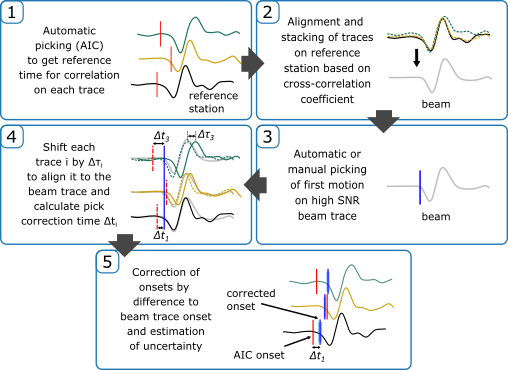6.4 KiB
Pick-Correlation Correction
Introduction
Currently, the pick-correlation correction algorithm is not accessible from they PyLoT GUI. The main file pick_correlation_correction.py is located in the directory pylot\correlation. The program only works for an obspy dmt database structure.
The basic workflow of the algorithm is shown in the following diagram. The first step (1) is the normal (automatic) picking procedure in PyLoT. Everything from step (2) to (5) is part of the correlation correction algorithm.
Note: The first step is not required in case theoretical onsets are used instead of external picks when the parameter use_taupy_onsets is set to True. However, an existing event quakeML (.xml) file generated by PyLoT might be required for each event in case not external picks are used.
A detailed description of the algorithm can be found in the corresponding publication:
Paffrath, M., Friederich, W., and the AlpArray and AlpArray-SWATH D Working Groups: Teleseismic P waves at the AlpArray seismic network: wave fronts, absolute travel times and travel-time residuals, Solid Earth, 12, 1635–1660, https://doi.org/10.5194/se-12-1635-2021, 2021.
How to use
To use the program you have to call the main program providing two mandatory arguments: a path to the obspy dmt database folder dmt_database_path and the path to the PyLoT infile pylot.in for picking of the beam trace:
python pick_correlation_correction.py dmt_database_path pylot.in
By default, the parameter file parameters.yaml is used. You can use the command line option --params to specify a different parameter file and other optional arguments such as -pd for plotting detailed information or -n 4 to use 4 cores for parallel processing:
python pick_correlation_correction.py dmt_database_path pylot.in --params parameters_adriaarray.yaml -pd -n 4
Cross-Correlation Parameters
The program uses the parameters in the file parameters.yaml by default. You can use the command line option --params to specify a different parameter file. An example of the parameter file is provided in the correlation\parameters.yaml file.
In the top level of the parameter file the logging level logging can be set, as well as a list of pick phases pick_phases (e.g. ['P', 'S']).
For each pick phase the different parameters can be set in the first sub-level of the parameter file, e.g.:
logging: info
pick_phases: ['P', 'S']
P:
min_corr_stacking: 0.8
min_corr_export: 0.6
[...]
S:
min_corr_stacking: 0.7
[...]
The following parameters are available:
| Parameter Name | Description | Parameter Type |
|---|---|---|
| min_corr_stacking | Minimum correlation coefficient for building beam trace | float |
| min_corr_export | Minimum correlation coefficient for pick export | float |
| min_stack | Minimum number of stations for building beam trace | int |
| t_before | Correlation window before reference pick | float |
| t_after | Correlation window after reference pick | float |
| cc_maxlag | Maximum shift for initial correlation | float |
| cc_maxlag2 | Maximum shift for second (final) correlation (also for calculating pick uncertainty) | float |
| initial_pick_outlier_threshold | Threshold for excluding large outliers of initial (AIC) picks | float |
| export_threshold | Automatically exclude all onsets which deviate more than this threshold from corrected taup onsets | float |
| min_picks_export | Minimum number of correlated picks for export | int |
| min_picks_autopylot | Minimum number of reference auto picks to continue with event | int |
| check_RMS | Do RMS check to search for restitution errors (very experimental) | bool |
| use_taupy_onsets | Use taupy onsets as reference picks instead of external picks | bool |
| station_list | Use the following stations as reference for stacking | list[str] |
| use_stacked_trace | Use existing stacked trace if found (spare re-computation) | bool |
| data_dir | obspyDMT data subdirectory (e.g. 'raw', 'processed') | str |
| pickfile_extension | Use quakeML files (PyLoT output) with the following extension | str |
| dt_stacking | Time difference for stacking window (in seconds) | list[float] |
| filter_options | Filter for first correlation (rough) | dict |
| filter_options_final | Filter for second correlation (fine) | dict |
| filter_type | Filter type (e.g. bandpass) | str |
| sampfreq | Sampling frequency (in Hz) | float |
Example Dataset
An example dataset with waveform data, metadata and automatic picks in the obspy-dmt dataset format for testing can be found at https://zenodo.org/doi/10.5281/zenodo.13759803
